Ease in Bodice: General
These explanations on block ease are for those people new to patternmaking and sewing, and may have the same problems I did understanding ease in the bust and at the underarm level. Important: In this article, I use the term Underarm Level in place of Upper Bust or High Bust. They are the same thing, but in this case, the Underarm Level seems to make more sense in the context. In other articles, I use Upper Bust.
Why is the armhole the same width as the bust?
When I first started making my bodice block, one of the struggles I had was understanding the width of the bodice block, as it seemed based on the bust measurement, but I could see that the this was the same width at the underarm level. This puzzled me particularly as I didn't think there should be that much ease in the armhole; I always had too much ease there when I created blocks. The other part of the confusion was that block was created using my bust measurement, yet it still seemed too tight in the bust. It seemed there should be 10cm or thereabouts) ease, so why was it still tight in the bust? I'll cover these two issues separately, starting with the problem of the ease at the underarm level.
Issue #1: Ease at Underarm
On the image below (which is to scale), I have used Winifred Aldrich's instructions and her Size 10 measurements, which has a bust of 84cm, to create a block. Aldrich's instructions for a Close Fitting Bodice Block results in a block to hip level, but I have cut it off at the waist and applied the Classic Waist Shaping she recommends in another section.
- The Width of the Block is half the bust (84cm ÷ 2 = 42cm) + 5cm ease.
- The total width of this Bodice Block (Front & Back) is therefore 47cm.
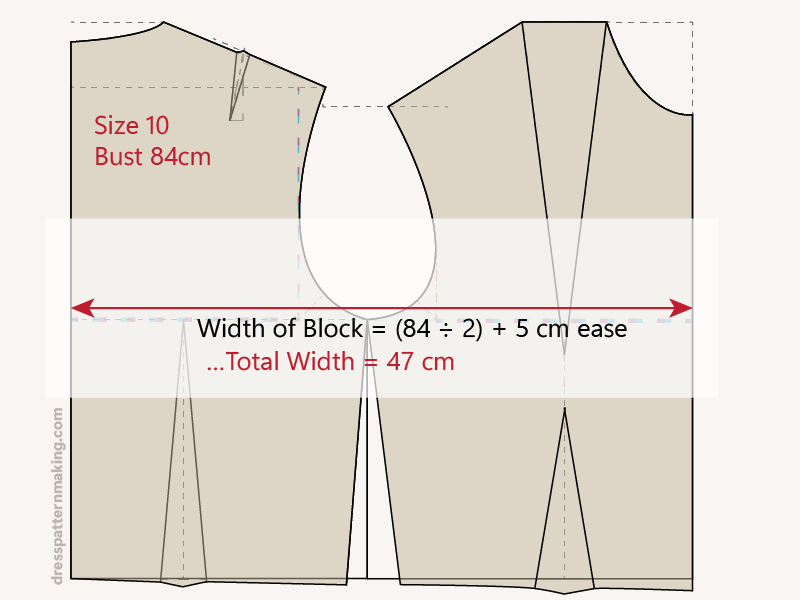
It is obvious from the image that although we are basing the width of the block on the bust measurement (which is the widest part of the bodice), the widest part of the actual block (47cm), is at the underarm level, not the bust. At the bust level it will be less than 47cm (see Ease in Bodice: Aldrich for some approximates).
Why is it so wide at the underarm level?
The (maybe obvious) answer is that the armhole level needs more ease than the bust, given the nature of the arm and the how we need to move our arms forward, back and up. Without a fair bit of ease, the arm would be too constricted. Given that the basic Bodice Block is to be used with sleeves (i.e. it is not a Sleeveless Block), it is even more essential to have a generous amount of ease. The nature of the sleeve requires more ease so that you can lift your arms away from your body; with insufficient ease, you would be very uncomfortable.
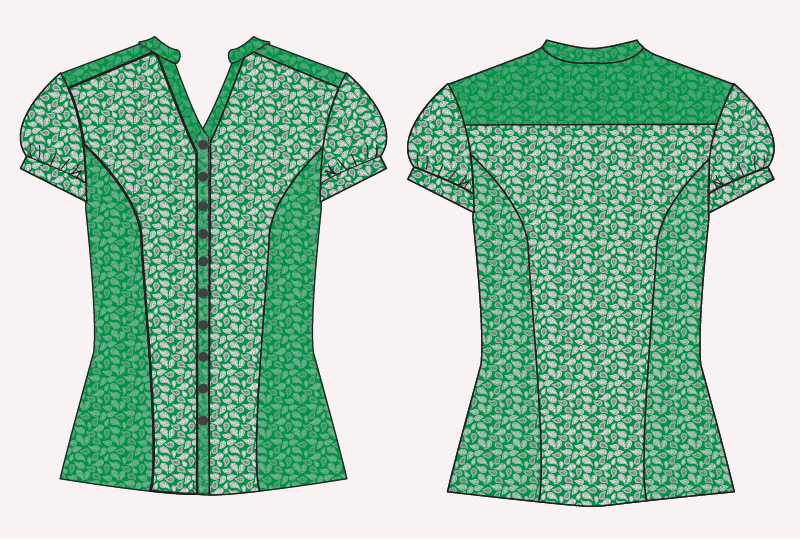
So: there is more ease at the underarm level than there is at the bust level because more is needed there. That seems fairly simple.
BUT... there is something which complicates things. There is an assumption that the difference between the measurement of the underarm and the bust is 5cm (2 inches).
Why 5cm (2 inches?). That is a B-cup.
This block is assuming that you have an underarm measurement of 79cm because your bust is 84cm. (Or: You have a bust measurement of 84cm, the underarm is 5cm less than the bust, therefore the underarm measurement is 79cm).
That becomes a problem when your underarm measurement is NOT the assumed 5cm less than your bust.And this is why I had so much difficulty understanding why the block width was based on the underarm. For me, the difference between my underarm level and my bust is much greater - it's 10cm. Using these block making instructions (which I didn't realize assumed my armhole level measurement) therefore resulted in far too much ease in the underarm for me. (i.e. My bust is 98cm, so these block making instructions resulted in an underarm level width of 93cm. If I was 93cm, I'd have 12cm ease. As I am 88cm, I'd have 17cm ease). (See Bust Cup Sizes for difference between bust and underarm for each bust-cup.)
These books that give instructions for creating these blocks with an assumed B-cup also give directions on how to make changes to your block to make it fit. But the problem is if you don't have a basic understanding of why you are having the problem, it's very difficult to understand what changes to make. For example; even though the block I created had so much ease in the underarm, it still felt tight across the bust (because of a separate issue: the bust-cup created is also for a B-cup), and the directions seemed to say that a Large Bust Adjustment was the way to correct the tightness in the bust. It also seemed to suggest that this would fix the issue of the armhole problem I was having. In fact doing just a Large Bust Adjustment with a block already too wide at the underarm level, just compounded the problem and created far more confusion for me. (See Large Bust Adjustment: Gotcha)
Examples of The Issue
If you look at the image below there is a mannequin that has 1-inch difference between the bust and underarm, which is the definition of an A-bust-cup. There is also a cast of my body with has a difference of almost 4 inches, which is the definition of a D cup.
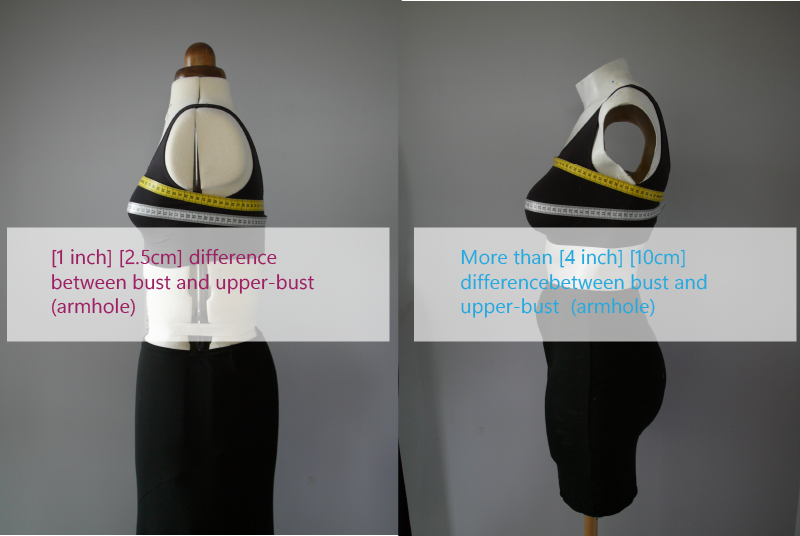
The Assumptions
- Mannequin is 98cm in bust, (therefore) 93cm at underarm level
- My body is 98cm in bust, (therefore) 93cm at the underarm level
The Reality
- Mannequin is 98cm in bust, 95.5 at underarm level
- My body is 98cm in bust, 88cm at the underarm level
If we made blocks for the mannequin and me using the standard instructions, it would assume both of us were 93cm at the underarm level. There would be insufficient ease for the mannequin at the underarm level, and far too much for me.
Issue #2: Ease in the Bust
The other half of the problem
When creating my first blocks using these instructions that assumed a B-cup, I not only ended up with too much ease in the underarm, it still seemed too tight in the bust. This was another thing that really confused me, as it seemed to have the right width at bust level.
The problem was the size of the dart created.
The assumption of a B-cup is made not only at the underarm-level in the block instructions, it is also made in the size of the dart that is created for the bust.
Given that the width of the fabric across your bust is your bust measurement + ease, it may be difficult to visualize how this can still result in tightness around the bust.
In the image below you can see what a B-cup looks like compared to a D-cup, for the same underarm (upper-bust) measurement.
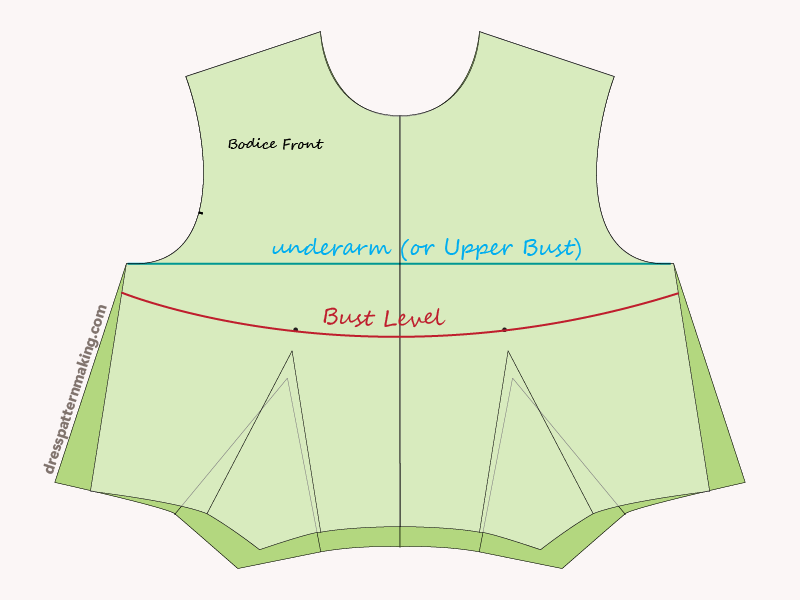
There doesn't seem to be much difference across the bust (shown by the red line) at all with these two bust-cups. Yet the B-cup will pull in the bust area and be uncomfortable on a D-cup figure; usually it will push the bust down and pull at the armhole. Hopefully the following three images will help you understand how this happens; how the B-bust from the image above will produce a bad fit on a D-cup figure, even through the bust measurement seems correct.
Bust-Cup Image 1
In this first image, I am showing you what happens when you put a garment drafted for a B-Cup onto a figure with a D-Cup. The white shaded area represents the B-cup fabric from the above image. The waist dart has not been sewn in, so the fabric flares out from the bust. The red area is what is missing to make this a comfortable fit - it is the difference between the B-cup and D-cup. The white and the red together make up the D-cup. Looking at the previous image, you can see how this translates to the flat fabric.
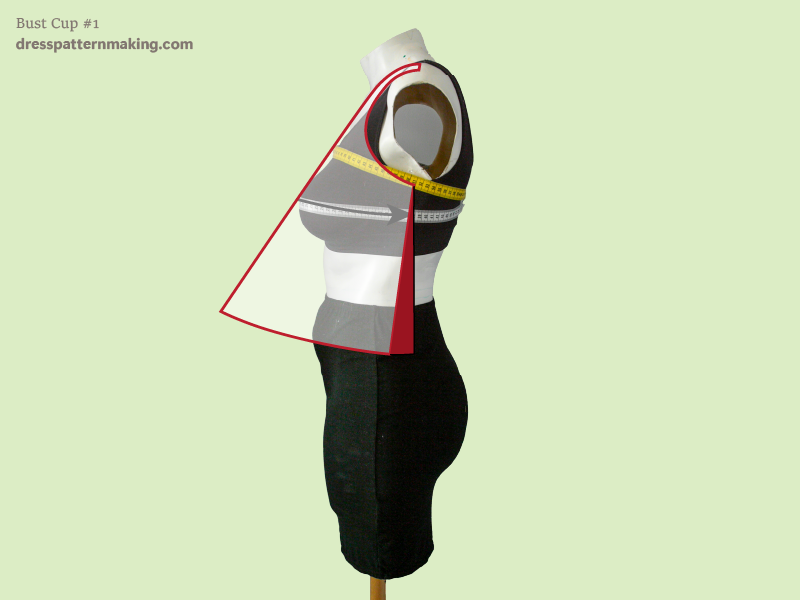
Bust-Cup Image 2
In this second image, the red part was removed so we can see what happens if we have to use the B-cup. In order to sew the front to the back, we will need to pull the side seam across to the blue line.
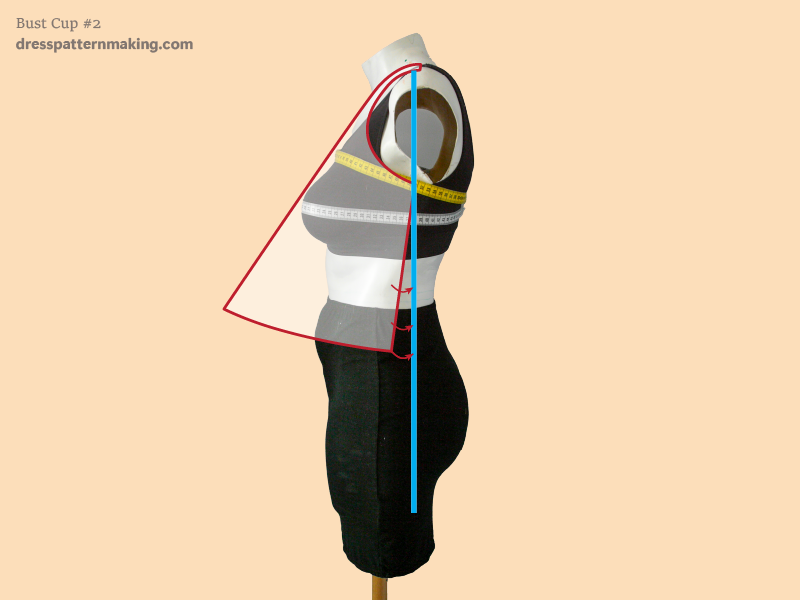
Bust-Cup Image 3
In this third image, I have pivoted the 'fabric' from the armhole, to bring the side seam down where the Bodice Front side seam needs to meet the Bodice Back side seam.
(There are of course limitations to this 2D representation, so you do have to use your imagination).
The yellow shape with the red outline is the original, the blue/green shape is after it has been pulled to meet at the side-seam. The fabric now no longer slopes down over the bust; it will pull or push the bust down, creating stress across the bust. The shoulder point has also come forward and up (blue arrow), but in real life the shoulder seam would stay where it was, and you would get pulling from the shoulder down to the bust, and/or from the armhole to the bust. The arrows show where the problems will occur. This B-cup would feel tight in the bust, with stress from the shoulder and/or the armhole to the bust.
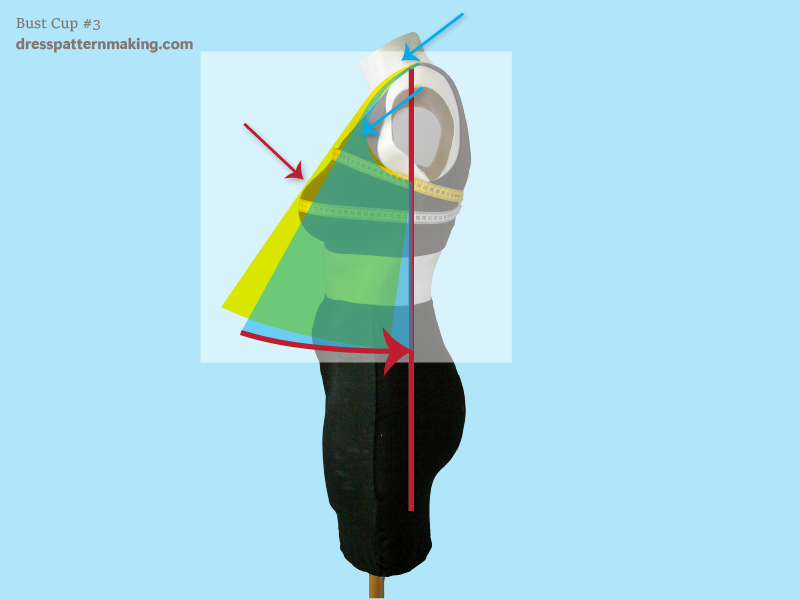
Ideal amount of ease in the Bust and Underarm
I want to be clear about how much ease is needed in the underarm and bust areas. From the investigation I have done, most Bodice Blocks (for Sleeves) using the standard B-cup assumptions end up with around about 7.5 cm | 3 inches in the bust, and therefore 12.5-cm | 5 inches in the underarm/upper-bust. These are reasonable amounts of ease for the bust and the underarm for all bust-cup sizes in a Bodice Block with sleeves.
As already covered above, you will not end up with this amount of ease in the bust and underarm if you are using block making instructions that assume a B-cup, and you are not a B-cup. These amounts are what you NEED for a comfortable fit for a Bodice with Sleeves.
Sleeveless Blocks will end up with less ease: both in the underarm and the bust, but there will still be more ease in the underarm than the bust.
The amount of ease is not necessarily straightforward: i.e. Not just the amount of ease added in the directions
Sometimes the amount of ease in the bust and the upper-bust is not as straightforward as it may appear. For example, in the first image at the top of the page (the Aldrich block), you may assume that there is 10cm ease in the underarm area. That is not actually the case. There is actually 7 cm (2.75 inches) ease in the bust and 12.75 cm (5 inches) inches ease in the armhole. (See the article Ease in Bodice: Aldrich for look at how I have come to this figure).
Similarly, when I first looked at Armstrong's instructions for the bodice block, I thought there was 2 inches ease in the Bodice Block, which is incorrect. Creating a block using her measurement charts ends up with the following ease: 3.25 inches (8.25 cm) in the bust 5.25 inches (13.25 cm) in the underarm. (See the article Ease in Bodice: Armstrong for how I have come to this figure).
Summary
This point of this article was to clarify the amount of ease needed for the bust and the underarm and to explain why you may not be getting this amount of ease when creating a block that assumes a B-cup.
The instructions I have written for creating a Bodice Block does not contain these assumptions; the block width is based on your underarm level measurement, and the correct bust-cup size can be created within the block creation process. If you create a bodice block using my instructions you will end up with the ideal amount of ease in the bust and the underarm, your block will be based on your underarm level measurement, and you will have the correct bust-cup. One article I would recommend you read beforehand is: Why Upper Bust and Not Bust? I am not suggesting that your block will produce a perfect fitting toile by using my instructions - you may have other fitting issues. However, using my instructions will save you having to make these two (significant) adjustments to your block if you do not have a B-cup. You will be starting your fitting with a block that has less problems. That is a huge bonus as it not only saves you a lot of work, it eliminates confusion. (And avoids the Large Bust Adjustment Gotcha!). Go back to the >> Analyzing Other Bodice Block Making Instructions Menu

